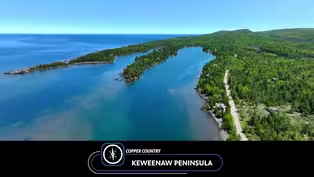Destination Michigan
Sault Historic Sites
Clip: Season 16 Episode 4 | 5mVideo has Closed Captions
Sault Historic Sites
From the winding St. Marys River to the Sault Ste. Marie skyline, we’re heading to the Upper Peninsula to uncover incredible stories from the past
Problems playing video? | Closed Captioning Feedback
Problems playing video? | Closed Captioning Feedback
Destination Michigan is a local public television program presented by WCMU
Destination Michigan
Sault Historic Sites
Clip: Season 16 Episode 4 | 5mVideo has Closed Captions
From the winding St. Marys River to the Sault Ste. Marie skyline, we’re heading to the Upper Peninsula to uncover incredible stories from the past
Problems playing video? | Closed Captioning Feedback
How to Watch Destination Michigan
Destination Michigan is available to stream on pbs.org and the free PBS App, available on iPhone, Apple TV, Android TV, Android smartphones, Amazon Fire TV, Amazon Fire Tablet, Roku, Samsung Smart TV, and Vizio.
Providing Support for PBS.org
Learn Moreabout PBS online sponsorship(screen whooshing) (tranquil music) - This is the Museum Ship Valley Camp docked in the Sault since July 4th, 1968, the city's tricentennial.
Once a working freighter, now she houses hundreds of maritime artifacts.
Paul Sabourin is part historian, part curator, and all heart when it comes to preserving this Great Lakes legacy.
- This year, one would have to remember November 10th, 1975 and on Lake Superior, the SS Edmund Fitzgerald went to the bottom.
(lively music) - [Jamie] Below the deck, a documentary plays in a converted cargo hold, a somber tribute to 29 men lost aboard the Edmund Fitzgerald, which sank on a stormy night, November 10th, 1975.
- After the investigation by the US Coast Guard, then the two lifeboat, and I refer to it as two because there were two on the Edmund Fitzgerald.
But in this case here we have one and a half lifeboat.
So lifeboat number two was spotted and recovered on the shore of Ontario, Lake Superior.
Lifeboat number one was spotted the next morning by the Arthur M. Anderson at about 8 o'clock on November the 11th, floating upside down.
Thanks to Jimmy Hobaugh, who was our executive director and retired US Coast Guard, we ended up with the two lifeboats.
And with that then we know that Gordon Lightfoot with "The legend lives on from the Chippewa on down of the big lake they call Gitche Gumee.
- [Jamie] Elsewhere, tributes to the Carl D. Bradley, which sank in November of 1958.
Of the 35 crew members, 33 died in the sinking.
The valley Camp also contains this carved eagle rescued from the wreckage of the Vienna, another ship that went down in Whitefish Bay, along with paintings, ship models and memorials.
- This is also the Captain John P. Wellington Great Lakes Marine Hall of Fame.
The Hall of Fame, as you can see around here , are all Hall of Famers inductees.
So every second year, we have an alternate Canadian American that's inducted to the Hall of Fame.
And it is very much a dedication and especially one that would commemorate the maritime involvement of that particular person.
- [Jamie] Above deck, you get an up close look at where the crew worked, ate, and slept, places where you can easily imagine them in the galley, playing cards and eating meals together.
Just a few blocks away from the Valley Camp, the Tower of History.
Built in 1968, it rises 210 feet up, offering views of Sault Ste.
Marie, the International Bridge that connects the community to Canada and the ever-changing Soo Locks.
- One can go in, again six months of the year, and either go up 292 steps if they're fit and willing.
But the other option is to push on the button and the elevator will whisk you up 45 seconds.
And from there, you'll be able to see the view of the city of Sault Ste.
Marie in all directions.
- [Jamie] And to round out the trio of Sault historic sites, the River of History Museum.
Exhibits inside follow the story of the region from ice glaciers to Native American life, fur traders, missionaries, and modern-day Michigan.
It's a full arc of the region's history told across centuries.
- I would say welcome to Sault Ste.
Marie.
Take I-75 if you're coming from south, take M-28 if you're coming from the west.
And if you're coming from the east and it's points of Canada, cross the bridge.
Come over to Sault Ste.
Marie, Michigan and make it a point of visiting the Museum Ship Valley Camp, the Tower of History, and also all of the other sites that are here, a day, two days, three days.
There's camping, there's facilities, and we always say welcome to the Sault.
(screen whooshing)
Providing Support for PBS.org
Learn Moreabout PBS online sponsorshipSupport for PBS provided by:
Destination Michigan is a local public television program presented by WCMU


















